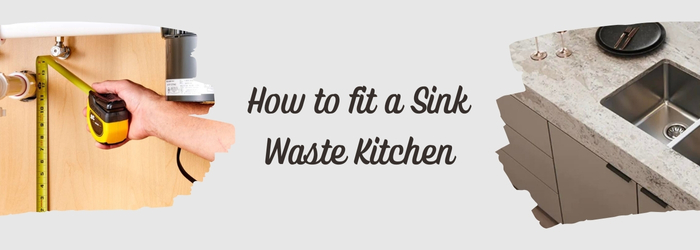Details of How to fit a Sink Waste Kitchen:
Installing or replacing a kitchen sink waste might seem like a daunting task, but with the right tools and knowledge, it’s a manageable DIY project. A properly fitted sink waste ensures efficient drainage and prevents leaks, contributing to the functionality and aesthetics of your kitchen. In this guide, we’ll walk you through the step-by-step process of fitting a kitchen sink waste, empowering you to tackle this project with confidence.
Step 1: Gather Your Tools and Materials
Before starting the installation process, gather all the necessary tools and materials. You’ll typically need:
- Sink waste kit (including the waste trap, washers, and connectors)
- Adjustable wrench
- Plumbers tape
- Pipe cutter or hacksaw
- Pipe wrench (if needed)
- Bucket or towels (to catch any water spills)
- Sealant (optional, for extra security)
- Make sure you have everything on hand before you begin to avoid interruptions during the installation.
Step 2: Remove the Old Waste
If you’re replacing an existing sink waste, start by disconnecting the old one. Turn off the water supply to the sink and place a bucket or towels beneath the pipes to catch any water. Use an adjustable wrench to loosen the nuts connecting the waste pipes to the sink and the drain. Once loosened, carefully remove the old waste assembly.
Step 3: Prepare the New Waste Kit
Before fitting the new waste, ensure all components are clean and free of debris. Familiarize yourself with the parts of the waste kit, including the trap, connectors, and washers. Check that you have the appropriate size and type of waste kit for your sink.
Step 4: Install the Sink Strainer
Insert the sink strainer into the sink’s drain hole, ensuring a snug fit. If necessary, use plumbers tape to secure the strainer in place and create a watertight seal.
Step 5: Connect the Waste Trap
Next, assemble the waste trap according to the manufacturer’s instructions. Typically, this involves connecting the trap’s curved section to the sink strainer and the straight section to the drain pipe. Use the appropriate washers and connectors to ensure a tight seal at each connection point.
Step 6: Secure the Connections
Once the waste trap is in place, use an adjustable wrench to tighten the nuts and connectors, securing the connections. Be careful not to over-tighten, as this could damage the pipes or fittings.
Step 7: Test for Leaks
After fitting the sink waste, turn on the water supply and check for any leaks. Look for drips or puddles around the connections and tighten them if necessary. If you notice any leaks, disassemble the affected area, reapply plumbers tape or sealant, and reassemble.
Step 8: Finishing Touches
Once you’ve confirmed that there are no leaks, clean up any excess sealant or debris around the sink area. Double-check that all connections are secure and properly tightened.
Conclusion of How to fit a Sink Waste Kitchen:
Fitting a kitchen sink waste may seem intimidating at first, but with patience and attention to detail, it’s a manageable task for most DIY enthusiasts. By following this step-by-step guide and taking the time to ensure proper installation, you can enjoy a well-functioning sink with efficient drainage and minimal risk of leaks. If you encounter any difficulties or are unsure about any step, don’t hesitate to seek guidance from a professional plumber. Happy plumbing!

